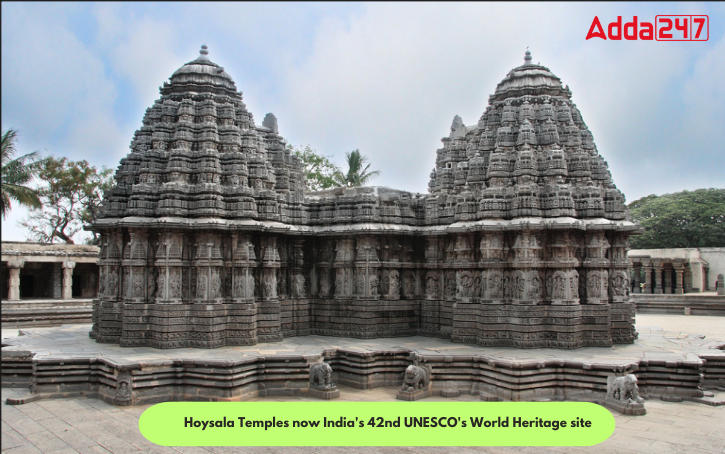The Sacred Ensembles of the Hoysala, the famed Hoysala temples of Belur, Halebid and Somananthpura in Karnataka have been added to the United Nations Educational, Scientific and Cultural Organization (UNESCO) World Heritage list. This inclusion marks the 42nd UNESCO World Heritage Site in India and comes just a day after Rabindranath Tagore’s Santiniketan also received this distinguished recognition.
The temples were finalised as India’s nomination for consideration as World Heritage for the year 2022-2023. The ‘Sacred Ensembles of the Hoysala’ have been on UNESCO’s Tentative list since April 15, 2014. All these three Hoysala temples are already protected monuments of the Archaeological Survey of India (ASI).
The Hoysala temples are known for their intricate carvings and exquisite architecture. They were built by the Hoysala Empire, which ruled over a large part of southern India between the 10th and 14th centuries. The three temples that have been inscribed on the UNESCO World Heritage List are:
- Chennakeshava Temple at Belur
- Hoysaleshwara Temple at Halebidu
- Keshava Temple at Somanathapura
What is the history and significance of Sacred Ensembles of the Hoysala?
The sacred ensembles of the Hoysalas, constructed during the 12th and 13th centuries are represented here by the three components of Belur, Halebid, and Somnathapura. While the Hoysala temples maintain a fundamental Dravidian morphology, they exhibit substantial influences from the Bhumija style prevalent in Central India, the Nagara traditions of northern and western India, and the Karnataka Dravida modes favoured by the Kalyani Chalukyas.
The Hoysalas were a powerful dynasty that ruled over much of southern India from the 11th to the 14th centuries. The Hoysala kings were known for their patronage of the arts, and they built many temples and other religious structures during their reign. The Sacred Ensembles of the Hoysala are the most impressive examples of Hoysala architecture, and they are a testament to the dynasty’s wealth and power.
The three most important Sacred Ensembles of the Hoysala are
- Belur: The Chennakeshava Temple at Belur is the largest and most elaborate of the Hoysala temples. It is dedicated to the Hindu god Vishnu, and it is covered in intricate carvings depicting gods, goddesses, and scenes from Hindu mythology.
- Halebidu: The Hoysaleswara Temple at Halebidu is another impressive Hoysala temple. It is dedicated to the Hindu god Shiva, and it is known for its exquisite soapstone carvings.
- Somnathapura: The Keshava Temple at Somnathapura is a smaller Hoysala temple, but it is no less impressive than the temples at Belur and Halebidu. It is known for its harmonious proportions and its beautiful carvings.
The Sacred Ensembles of the Hoysala are significant for a number of reasons. First, they are some of the most beautiful and intricate examples of Hindu temple architecture in the world. Second, they are a testament to the wealth and power of the Hoysala dynasty. Third, they provide a unique glimpse into the religious and cultural life of the Hoysala people.
What does it signify when a site is listed on the World Heritage List?
According to UNESCO, when a country becomes a signatory to the World Heritage Convention and has its sites inscribed on the World Heritage List, it often brings about increased recognition and appreciation for heritage preservation among both its citizens and government. Furthermore, the country may avail itself of financial assistance and expert guidance from the World Heritage Committee to bolster efforts aimed at safeguarding these precious sites.
When a site is listed on the World Heritage List, it signifies that it is of outstanding universal value to humanity. This means that it is a place of exceptional cultural or natural significance, and that its preservation is important for the benefit of all people.
World Heritage sites can be cultural, natural, or mixed. Cultural sites include things like ancient ruins, historical monuments, and religious buildings. Natural sites include things like national parks, wildlife refuges, and geological formations. Mixed sites include places that have both cultural and natural significance, such as a cultural landscape or a national park with important cultural sites.
There are currently 1,172 World Heritage Sites in 166 countries around the world. Some of the most famous World Heritage Sites include the Great Wall of China, the Taj Mahal, the Grand Canyon, and the Great Barrier Reef.
Being listed on the World Heritage List brings a number of benefits, including
- International recognition and prestige
- Legal protection under the World Heritage Convention
- Access to funding from the World Heritage Fund
- Increased tourism revenue
However, listing on the World Heritage List also comes with certain responsibilities. Countries with World Heritage Sites must take steps to protect and conserve these sites, and to ensure that they are accessible to the public.
Overall, being listed on the World Heritage List is a great honor and a sign that a site is truly special and worth preserving for future generations.
Here are some of the specific things that World Heritage sites can signify
Cultural sites:
- The achievements of human creativity and ingenuity
- The diversity of human cultures and traditions
- The importance of cultural identity and heritage
Natural sites:
- The beauty and wonder of the natural world
- The importance of biodiversity and conservation
- The interconnectedness of nature and culture
World Heritage sites also play an important role in education and tourism. They provide opportunities for people to learn about different cultures and natural environments, and to experience the beauty and wonder of the world.



 Indian Olympic Medal Winners List Till N...
Indian Olympic Medal Winners List Till N...
 Who is the Inventor of the Gramophone?
Who is the Inventor of the Gramophone?
 HS Dhaliwal Appointed New DGP Of Andaman...
HS Dhaliwal Appointed New DGP Of Andaman...
